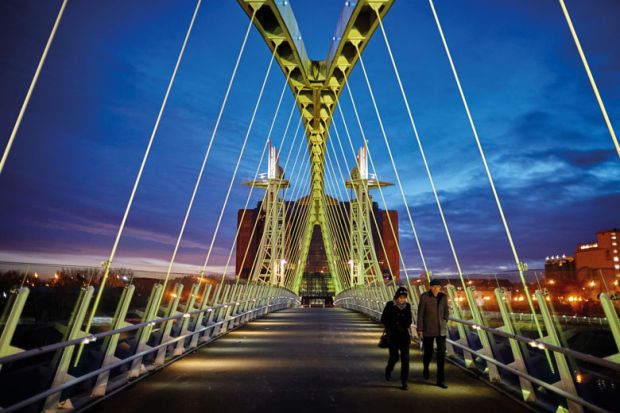Salford, the city in Greater Manchester, is one of England’s most deprived areas – and University of Salford vice-chancellor Helen Marshall sees a limit to what the institution can do for that area without more jobs coming. “Let’s say we get 80 per cent of the youngsters in Salford all skilled up: no jobs in Salford, so what happens? They all move away. It becomes a ghost town, and it becomes more deprived.”
There is no prospect of boosting struggling regions “if you don’t bring the jobs, the infrastructure and the skills as a golden triangle”, she told Times Higher Education.
Salford is working on a big question with wider relevance: how exactly universities might help to create jobs, thus making the benefits of their education and research stick in their regions.
The university’s ambition to put skills together with attracting jobs is seen in the combination of the Greater Manchester Institute of Technology (IoT) it is leading – opening in September as part of the government’s programme of higher technical education institutions, with focuses including construction, artificial intelligence and cybersecurity skills, and partners including regional further education colleges and employers such as Siemens, TalkTalk and GCHQ – alongside proposals for an innovation district adjoining its campus. Consultation is under way on the Crescent Innovation North plans, which would include research and industry space, a hotel, shops and more than 2,650 homes.
A kernel of that potential innovation district has just emerged in the shape of the university’s £16 million North of England Robotics Innovation Centre, funded by the European Regional Development Fund (before the UK lost that funding in Brexit) with additional support from Research England. Aims include ensuring that small and medium-sized enterprises benefit from automation and thus higher productivity, boosting, for example, a key local and regional sector like the food industry, ranging from a local sandwich maker to companies working across the M62 corridor.
On infrastructure, Professor Marshall is “talking to Andy Burnham [the Greater Manchester mayor] about tramways, trains, buses”, with the aim of better linking the university and the potential innovation district to the wider region and to MediaCityUK, the nearby development that houses significant sections of the BBC and ITV, by the Manchester Ship Canal that fuelled Salford’s industrial heyday.
The university can base its ambitions on a solid financial base. Under Professor Marshall’s leadership – she will retire in the summer after eight years in charge – and since the abolition of student number controls, it has grown from roughly 17,000 full-time equivalent students to about 26,000, with an aim to near 30,000.
That has funded an array of new buildings, giving a smart look to a campus surrounded by dual carriageways and industrial estates. The Victorian red-brick Peel Building now stands alongside glossy newcomers such as the £65 million Science, Engineering and Environment Building.
The institution is talking to the city council about the innovation district, said Professor Marshall. “You can sell land, take the proceeds and build social housing. [But] where are you going to be in five years’ time? Because you’ve sold the land, you haven’t got that asset, you’ve built social housing – that needs maybe a refurb.
“Or do you build the innovation district, attract business, get the pipeline of local talent, get them good jobs – then you raise the bar.”
With Covid and Russia’s war in Ukraine having highlighted the UK’s reliance on imports, there is an increased need for universities to contribute to Industry 4.0, while “the government needs an industrial strategy to industrialise the economy more than it is”, she added.
The innovation district would aim to spark jobs from Salford’s research (the university rose 22 places to 65th in THE’s Research Excellence Framework 2021 league table). Key strengths include another gleaming new £16 million facility, Energy House 2.0, part-funded by European regional development money and aimed at accelerating progress towards net zero housing design. Two huge chambers are each able to accommodate a pair of detached houses and can simulate wind, rain and snow under a wide range of temperatures (one chamber was at a brisk −18ºC when THE visited – and they can go up to 40ºC).
It is a more modern successor to the terraced house of Salford’s original Energy House Laboratory. In the new version, rival housebuilders Barratt and Bellway have built test houses next to each other, typical suburban homes looking surreal indoors.
For Karl Dayson, pro vice-chancellor for research and innovation, there is an example here of the hope that the university could join up education and jobs: that local young people could be trained in skills for net zero housing at the IoT, then go on to work at a firm with a base on the innovation district.
“Firms need to be near where the knowledge is produced and then where the knowledge is transmitted: that’s universities,” he said. “That’s why universities are increasingly seen as catalysts for economic regeneration.”
Register to continue
Why register?
- Registration is free and only takes a moment
- Once registered, you can read 3 articles a month
- Sign up for our newsletter
Subscribe
Or subscribe for unlimited access to:
- Unlimited access to news, views, insights & reviews
- Digital editions
- Digital access to THE’s university and college rankings analysis
Already registered or a current subscriber? Login








